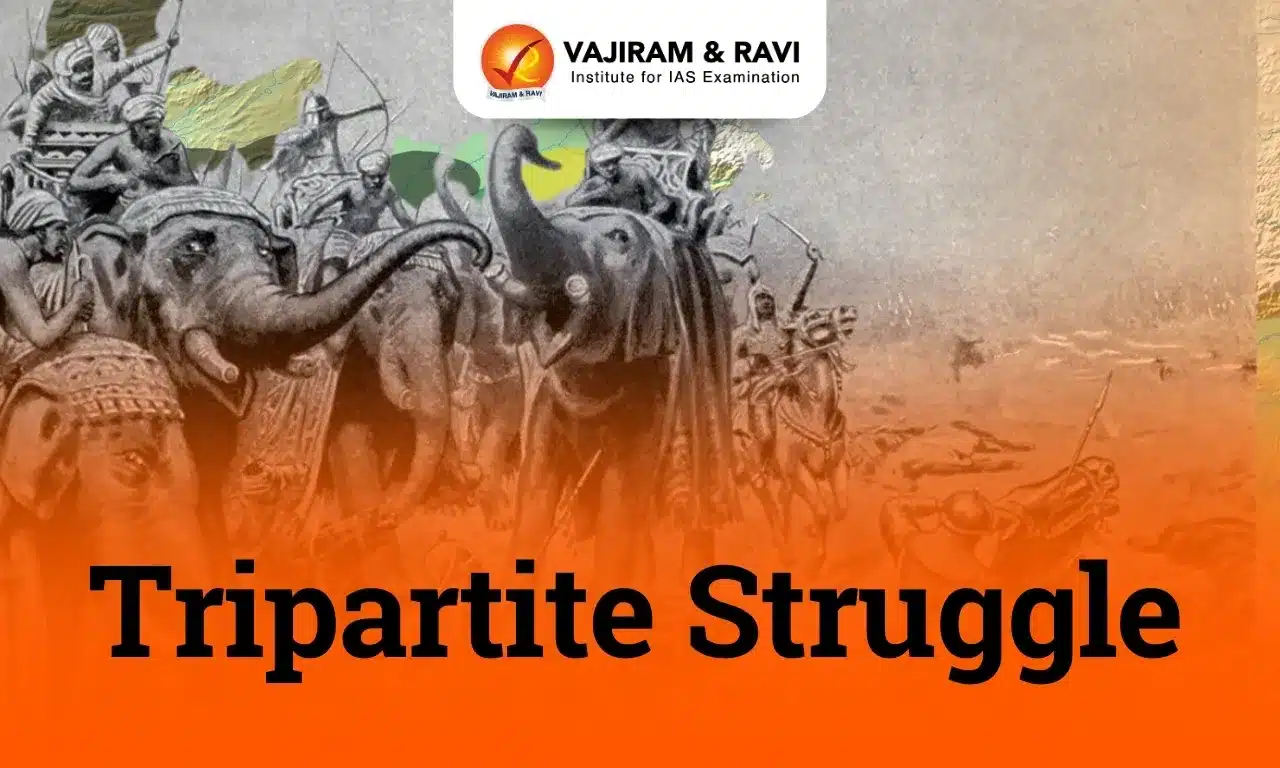Tripartite Struggle: The decline of the Gupta Empire paved the way for the rise of new powers vying for supremacy in northern India. The Tripartite Struggle, also known as the Kannauj Triangle Wars, was a conflict that took place in the 8th and 9th centuries in Northern India among three major empires: the Palas of Bengal and Bihar, the Pratiharas of Avanti, and the Rashtrakutas of the Deccan. This struggle was for control of the region and was a significant event in the history of medieval India. The conflict had multiple phases and causes, with the aftermath leading to changes in the region’s political landscape
Dynasties Involved in Tripartite Struggle
The Tripartite Struggle, also known as The Kannauj Triangle Wars, took place in the ninth century among three great Indian dynasties. The main contenders in the Tripartite Struggle were the following three great Indian dynasties:
| Empire | Description |
| The Pala Empire (750-1161 CE) | – Founder: Gopala, elected by feudal lords in 750 CE.
– Prominence: Bengal and Bihar regions. – Notable Ruler: Dharmapala, who established Vikramshila University and a Buddhist monastery in Gaya. – Legacy: Controlled significant parts of eastern and northern India for almost four centuries.
|
| The Gurjara-Pratihara Dynasty (730-1036 CE) | – Origin: Emerged from the Mandor region (near Jodhpur) in the 8th century.
– Extended empire’s reach to Kashmir under Mihir Bhoja. – Role: Crucial in checking Arab expansion, earning the title “Ranahastina” (lords of war). |
| The Rashtrakuta Dynasty (753-982 CE) | – Origin: Originating in the Deccan region, rose to prominence under Dantidurga.
– Peak: Under Krishna I, commissioned the Kailash temple at Ellora (rock-cut architecture). – Dominance: The Rashtrakutas, established dominance over the Deccan and Central India. |
Historical Evidence of Tripartite Struggle
Our understanding of the tripartite struggle and the era’s cultural and administrative aspects is derived from various historical sources:
- Inscriptions:
- The Ellora Record of Dantidurga, the Samangarh inscription, and the Navsari Grant provide insights into the Rashtrakuta dynasty’s history.
- The Gwalior Prashasti and the Barah copper plate celebrate the achievements of Mihir Bhoja.
- The Badal inscription mentions the Pala ruler Devapala’s victories over various dynasties.
- Literary works:
- Kalhana’s Rajatarangini chronicles the kings of Kashmir, including the territories of Mihir Bhoja.
- The Sanjan Copper plate inscriptions shed light on the reign of the Rashtrakuta king Amoghavarsha.
- Foreign accounts:
- Arab travellers like Al-Masaudi visited the Pratihara kingdom during Mahendrapala’s reign, providing valuable insights into the period.
Tripartite Struggle Causes
The main causes of the Tripartite Struggle, a significant conflict in medieval Indian history involving the Rashtrakuta, Pratihara, and Pala Dynasties, were:
- Significance of Kannauj: Kannauj, in the Gangetic plain, symbolised political dominance in medieval northern India, coveted for its prestige and authority. It was a major centre for politics, economy, and culture, strategically located to amplify its commercial importance on the Silk Road, facilitating regional and intercontinental trade.
- Weak rulers in Kannauj: During the late 8th and early 9th centuries, Kannauj was ruled by a succession of weak kings, including Indrayudha, Vijrayudha, and Chakrayudha, who were easily overthrown or subjugated by the more powerful empires vying for control.
- The desire for supremacy: The desire to become the “Sakala Uttarpathanatha” (lord of all of northern India) or “Uttarpathaswami” (lord of the northern region) motivated the Rashtrakutas and Palas, respectively, to extend their influence over Kannauj and the surrounding areas.
Tripartite Struggle Phases and Key Events
The Tripartite Struggle involving the Rashtrakuta, Pratihara, and Pala Dynasties, the conflict can be divided into two key phases:
Phase I: The Initial Conflict (790 CE-810 CE)
The first phase of the tripartite struggle began around 790 CE with a clash between the Pala king Dharmapala and the Pratihara ruler Vatsaraja at Prayaga (modern-day Allahabad).
- Vatsaraja emerged victorious, forcing Dharmapala to cede his western territories.
- However, Vatsaraja’s triumph was short-lived, as the Rashtrakuta king Dhruva Dharavarsha defeated him in a fierce battle in the Ganga-Yamuna doab region.
- Dhruva’s intervention prevented the consolidation of Pratihara control over Kannauj, as he was compelled to return south to address conflicts with the Chalukyasof Vengi.
Phase II: The Resurgence (810-836 CE)
Following Dhruva’s departure, Dharmapala seized the opportunity to recapture Kannauj and installed a vassal king, Chakrayudha, on the throne. Through successful expeditions,
- Dharmapala established himself as the “Lord of Uttarpath” (Uttarpathaswami), extending his influence over vast territories in northern India.
- However, this dominance was short-lived, as the Pratihara ruler Nagabhatta II invaded Kannauj, defeated Dharmapala in the Battle of Munger, and reinstated Pratihara’s control over the region.
- Nagabhatta II’s victory was short-lived, as the Rashtrakuta king Govinda III, son of Dhruva, launched an offensive and captured Kannauj.
- Govinda III’s triumph was fleeting, as he soon returned to the Deccan, allowing Nagabhatta II to regain control of Kannauj.
- This phase marked the emergence of the Pratiharas as the dominant power in central India.
Tripartite Struggle Consequences
The Tripartite Struggle had far-reaching consequences that shaped the political, cultural, and artistic landscape of medieval India:
- Consolidation of power: After nearly a century of conflict, the Pratihara emperor Nagabhatta II emerged victorious, establishing Kannauj as the capital of the Pratihara Empire, which ruled over northern India for nearly three centuries.
- Cultural Renaissance: The tripartite struggle fostered a vibrant cultural and artistic environment, with the competing empires patronising scholars, artists, and architects.
- This period witnessed the development of distinct architectural styles, such as
- the Nagara styleof the Pratiharas,
- the Bangla-domed temples of the Palas, and
- the Vesara styleof the Rashtrakutas, exemplified by the Kailash temple at Ellora.
- This period witnessed the development of distinct architectural styles, such as
- Linguistic development: The tripartite struggle coincided with the evolution and growth of regional languages like Kannada, Bengali, and Apabhramsha.
- The Rashtrakuta king Amoghavarsha contributed significantly to the development of Kannada literature, while the Pala rule saw the emergence of Proto-Bengali literature.
- Sanskrit literature also thrived during this period, with celebrated poets and scholars gracing the courts of Pala and Pratihara rulers.
- Weakening of Empires: The prolonged conflict took a toll on the resources and stability of the empires involved, ultimately leading to their gradual decline.
- The Pratiharas faced rebellions from feudatories, the Palas were weakened by frequent attacks from theMahmud of Ghazni, and the Rashtrakutas were challenged by the resurgent Cholas and the Paramaras of Malwa.
- Administrative developments: The Tripartite Struggle period witnessed the evolution and refinement of administrative systems, with the Pala and Pratihara Empires largely following the Gupta model, while the Rashtrakutas developed their distinct administrative structure.
Tripartite Struggle UPSC PYQs
Question 1: Consider the following pairs: (UPSC Prelims 2022)
King Dynasty
- Nannuka – Chandela
- Jayashakti – Paramara
- Nagabhata II – Gurjara-Pratihara
- Bhoja – Rashtrakuta
How many pairs given above are correctly matched?
- Only one pair
- Only two pairs
- Only three pairs
- All four pairs
Answer: (b)
Last updated on June, 2025
→ UPSC Notification 2025 was released on 22nd January 2025.
→ UPSC Prelims Result 2025 will be out soon for the CSE held on 25 May 2025.
→ UPSC Prelims Question Paper 2025 and Unofficial Prelims Answer Key 2025 are available now.
→ UPSC Calendar 2026 is released on 15th May, 2025.
→ The UPSC Vacancy 2025 were released 1129, out of which 979 were for UPSC CSE and remaining 150 are for UPSC IFoS.
→ UPSC Mains 2025 will be conducted on 22nd August 2025.
→ UPSC Prelims 2026 will be conducted on 24th May, 2026 & UPSC Mains 2026 will be conducted on 21st August 2026.
→ The UPSC Selection Process is of 3 stages-Prelims, Mains and Interview.
→ UPSC Result 2024 is released with latest UPSC Marksheet 2024. Check Now!
→ UPSC Toppers List 2024 is released now. Shakti Dubey is UPSC AIR 1 2024 Topper.
→ Also check Best IAS Coaching in Delhi
Tripartite Struggle FAQs
Q1. What was the Tripartite Struggle?+
Q2. What was the significance of Kannauj in the Tripartite Struggle?+
Q3. Who were the major rulers involved in the Tripartite Struggle?+
Q4. How did the Tripartite Struggle end?+
Tags: quest tripartite struggle


















